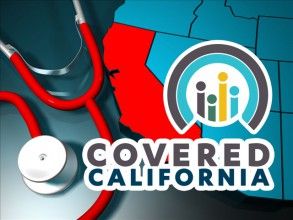Critics question costs under Covered California
by James Poulos | June 26, 2015 4:45 am
 [1]As the fate of the Affordable Care Act hung in the balance at the Supreme Court, bipartisan concern swirled around how Covered California is affecting the Golden State’s costs of care.
[1]As the fate of the Affordable Care Act hung in the balance at the Supreme Court, bipartisan concern swirled around how Covered California is affecting the Golden State’s costs of care.
“After surpassing its first year goal by 400,000 — signing up 1.1 million people in private plans — Covered California’s enrollment climbed to only 1.3 million this year, wildly off its 1.7 million target for 2015,” the San Jose Mercury News reported[2], calling the situation a “crossroads.”
“Experts are watching carefully because the financial health of the exchange depends on growing its number of enrollees. If that doesn’t continue — or even backslides — shrinking dollars could threaten the way the exchange now operates. Finally, provisions of the law designed to offset possible losses for health insurers will expire in 2017. That could also impact premiums — and enrollments — even further.”
The rocky road recalled to mind warnings from early Obamacare critics who raised the specter of a so-called “death spiral” brought on by insufficient enrollment to even out insurance risk across pools of beneficiaries. But according to the Mercury News, “Peter Lee, Covered California’s relentlessly upbeat executive director, remains unfazed.”
Lee has invested much of his time and reputation in the exchange’s success, at least relative to other, ailing setups in states around the country. Steeling his nerve, Covered California recently “awarded its executive director a $65,000 bonus,” just “four months after giving him a 24 percent raise,” as the Los Angeles Times observed[3]. That brought Lee’s annual salary to $333,120, according to California Healthline. (Meanwhile, Deputy Director Yolanda Richardson saw her yearly pay rise over 11 percent to $265,668; all told, the exchange’s top 14 most highly-paid executives all cleared five figures in income per month.)
Rising rates, unknown figures
One explanation for the handsome compensation packages would be familiar to advocates of high pay for CEOs in the private sector: retaining talent. Some consumer advocates, according to the Times, “have credited Lee with securing lower-than-expected rates from health insurers the last two years and reaching substantial enrollment of nearly 1.4 million people.”
But California Insurance Commissioner Dave Jones dismissed that claim. In an interview with State of Reform, Jones characterized[4] California’s health insurance providers as a virtual monopoly, “attributable in part to decisions made by Covered California and unchecked rate increases as top issues.”
Inside and outside the exchange, he said, “you have an extraordinary concentration of the market going to a handful of carriers. As a result, they function in a classical economic sense as monopolists or oligopolists who are able to dictate prices for what is an essential good that people desperately need and are willing to pay just about anything to get.”
Jones has raised hackles among Democrats for challenging Covered California’s effectiveness and propriety. But activists further to his left have created bigger headaches. Not all consumer groups have been kind to Covered California executives. In a letter to Lee, Santa Monica-based Consumer Watchdog demanded[5] that Covered California release its planned rate increases for next year. California “has successfully lobbied the federal government to delay public disclosure of qualified health plan rate change proposals for 2016,” the organization noted[6], becoming the only state in the nation to do so.
“Citizens of every other state now have access to proposed rate hikes, except the people of California, who are already disadvantaged by the absence of rate regulation in this state,” the letter warned.
Privacy worries
Complicating the picture of Covered California’s health, the exchange has spread unease among would-be allies by forging ahead with a controversial centralized data plan.
“Exchange officials say they’re planning to create a large database with information on patients’ doctor and hospital visits, and prescription drugs. The information could be used to determine whether patients are getting appropriate care,” KPBS reported[7], but “privacy rights experts are raising some questions.”
Concerns have extended to the prospect of a further leveling off in enrollment. “We’re very concerned that it’s going to chill people from getting health care,” said World Privacy Forum executive director Pam Dixon.
- [Image]: http://calwatchdog.com/wp-content/uploads/2015/04/covered-california.jpg
- reported: http://www.mercurynews.com/health/ci_28369164/covered-california-health-insurance-exchange-at-crossroads
- observed: http://www.latimes.com/business/healthcare/la-fi-obamacare-california-executive-pay-20150619-story.html
- characterized: http://stateofreform.com/news/industry/exchanges/2015/05/commissioner-dave-jones-on-the-big-missing-piece-of-ca-health-reform/
- demanded: http://www.consumerwatchdog.org/resources/covca_rates_letter_.pdf
- noted: http://yubanet.com/california/California-Only-State-In-Nation-To-Delay-Public-Disclosure-Of-Proposed-2016-Health-Plan-Rate-Hikes.php#.VYudskLFvVp
- reported: http://www.kpbs.org/news/2015/jun/22/covered-californias-plan-collect-health-info-raise/?utm_source=feedburner&utm_medium=feed&utm_campaign=Feed%3A+kpbs%2Flocal+(KPBS+News%3A+Local+Headlines)
Source URL: https://calwatchdog.com/2015/06/26/critics-question-costs-covered-california/